
IMPACT OF STABLECOINS ON EMERGING ECONOMIES
Part 1: Introduction
Context: The Rise of Stablecoins in the Context of Financial Globalization
In the era of financial globalization, stablecoins have emerged as a prominent phenomenon in the cryptocurrency landscape. Pegged to stable assets such as the USD, gold, or managed through supply-demand algorithms, stablecoins offer price stability that traditional cryptocurrencies like Bitcoin struggle to achieve. According to data from SoSoValue, the market capitalization of stablecoins has grown exponentially, from a few billion USD in 2017 to over $200 billion in 2025, accounting for a significant share of the total cryptocurrency market. This growth not only reflects the demand for a reliable medium of exchange but also underscores the potential of stablecoins to reshape the global financial system.
Importance of Stablecoins for Emerging Economies
Emerging economies, characterized by high inflation, underdeveloped banking systems, and stringent capital controls, are witnessing a strong adoption of stablecoins. In countries like Venezuela, Nigeria, and Argentina, stablecoins such as USDT and USDC have become tools for preserving asset value, reducing remittance costs, and expanding financial access. According to Chainalysis, these countries rank among the top in the Global Crypto Adoption Index, with stablecoins dominating transaction volumes. Stablecoins serve as a bridge between traditional and decentralized finance (DeFi), offering practical solutions to economic challenges in these markets.
Research Objectives and Scope
This study aims to analyze the dual impact of stablecoins on emerging economies, including benefits such as enhanced financial inclusion and reduced cross-border transaction costs, as well as risks like threats to national monetary policies and potential illicit activities. The research focuses on emerging economies in Latin America, Africa, and select Asian countries, supported by real-world examples and data from credible sources such as CoinMarketCap, The Block, and Chainalysis. The report also examines regulatory frameworks and the development of central bank digital currencies (CBDCs) as potential alternatives.
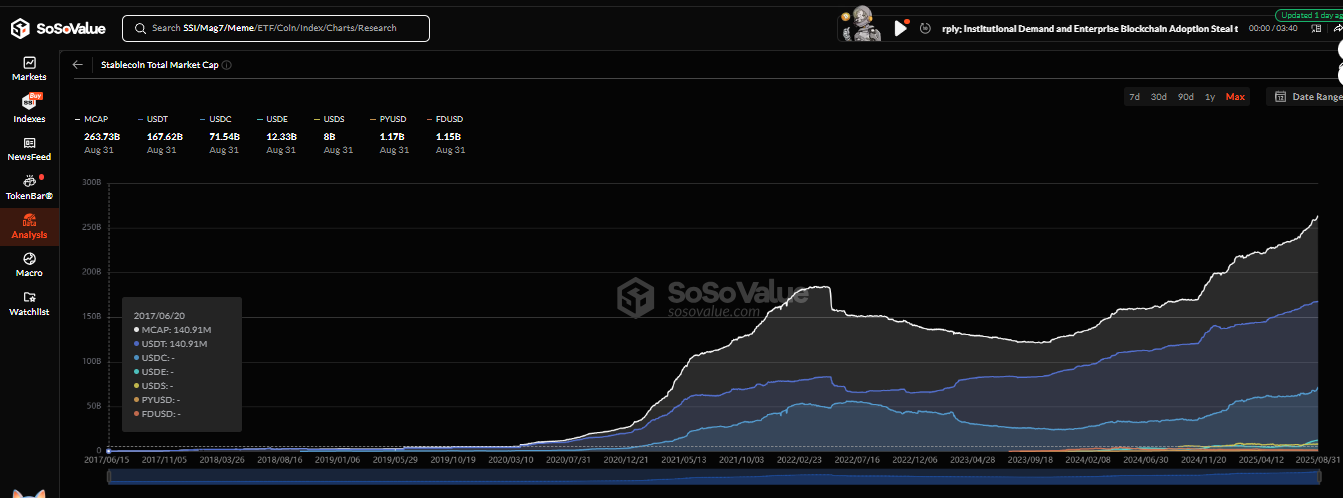
Part 2: Overview of Stablecoins
Definition and Types of Stablecoins
Stablecoins are a type of cryptocurrency designed to maintain stable value, typically pegged to assets like fiat currencies, commodities (e.g., gold, silver), or managed through algorithms. There are three main types:
Fiat-backed: Backed by fiat currencies like the USD (e.g., Tether’s USDT, Circle’s USDC), ensuring value stability through cash or equivalent reserves.
Crypto-backed: Secured by other cryptocurrencies, such as MakerDAO’s DAI, using smart contracts to maintain value.
Algorithmic: Employ algorithms to adjust supply and demand, such as FRAX, to maintain value without direct asset backing.
According to SoSoValue, USDT and USDC account for over 80% of the stablecoin market share in 2025, reflecting the dominance of fiat-backed models.
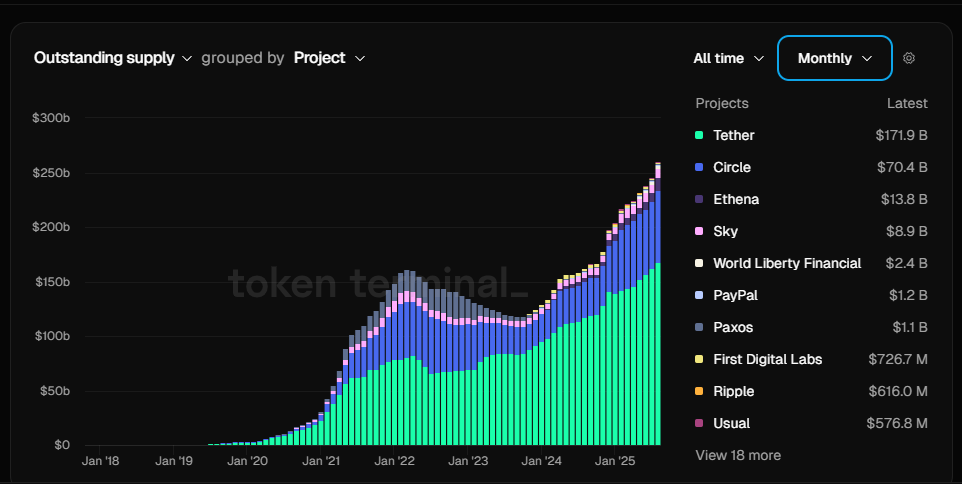
Reasons for the Strong Growth of Stablecoins
Stablecoins have thrived due to their ability to combine the stability of fiat currencies with the advantages of blockchain technology: fast transactions, low costs, and borderless accessibility. The rise of decentralized finance (DeFi) and the demand for cross-border payments have fueled this growth. Per SoSoValue, stablecoin market capitalization grew from $5.9 billion in 2017 to over $200 billion in 2025, with a compound annual growth rate (CAGR) exceeding 50%. Factors such as global inflation, instability of local currencies, and the need for financial inclusion in emerging economies further reinforce the role of stablecoins.
Role as a Bridge Between Crypto and Traditional Finance
Stablecoins act as intermediaries, enabling users to participate in cryptocurrency markets without exposure to price volatility. They are widely used in DeFi (lending, staking), international payments, and remittances. For example, platforms like Stellar and Ripple leverage stablecoins to reduce transaction costs compared to SWIFT. Stablecoins also enable businesses to integrate blockchain into commercial operations, serving as a bridge between traditional and decentralized finance.
Part 3: Economic Characteristics of Emerging Economies
Economic Characteristics
Emerging economies, such as those in Latin America, Africa, and parts of Asia, exhibit distinct economic features:
High Inflation: According to IMF data, countries like Venezuela (with inflation exceeding 1,000% in 2023), Argentina, and Zimbabwe frequently face hyperinflation, eroding the value of local currencies.
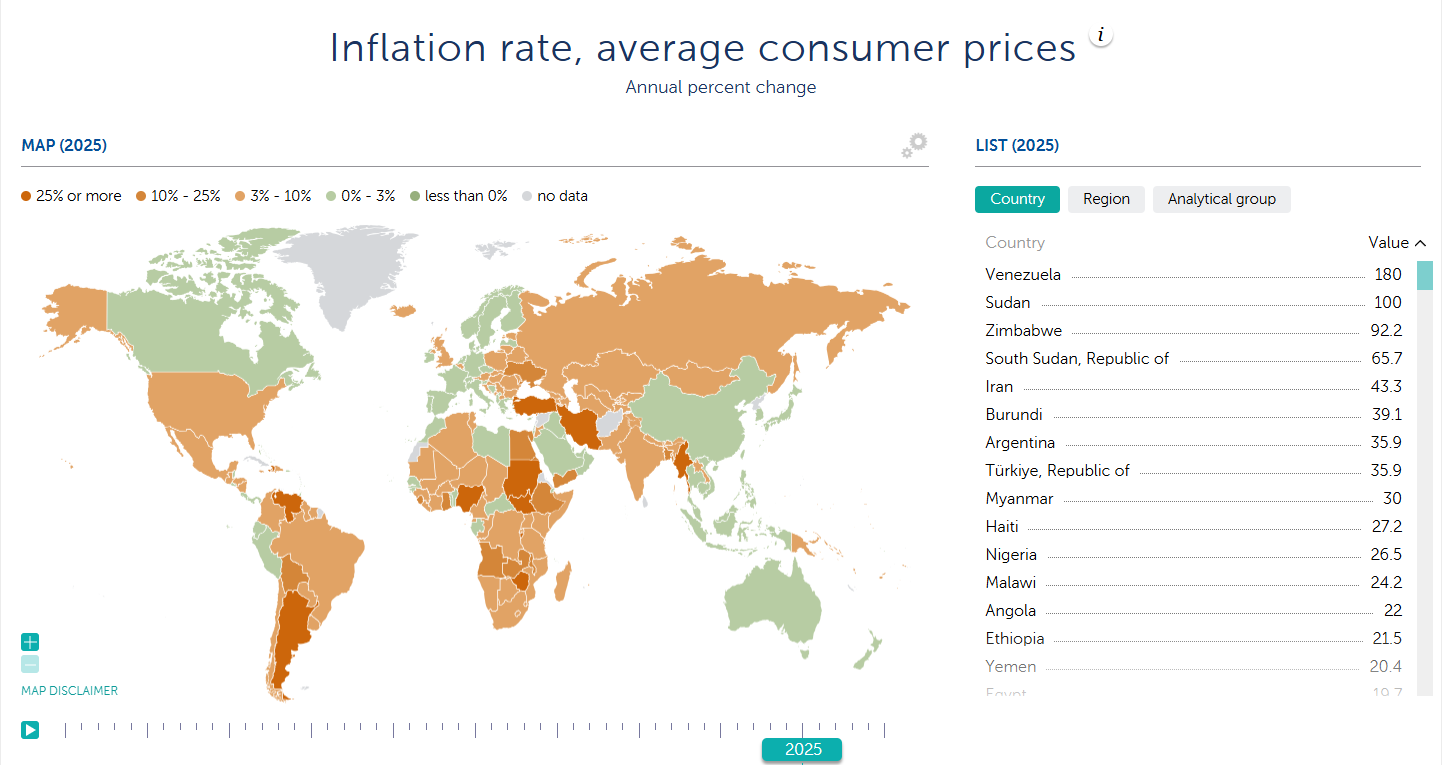
Weak Banking Systems: Financial systems in these countries are often inefficient, with low banking penetration (only 30-50% of the population in Africa has bank accounts, per World Bank data).
Strict Capital Controls: Nations like Nigeria and Vietnam impose restrictions on capital flows to protect exchange rates, complicating international transactions.
Common Challenges
Emerging economies face several challenges:
Lack of Confidence in Local Currencies: Continuous currency devaluation drives citizens to seek alternative assets like USD or gold to preserve value.
High Remittance Costs: According to the World Bank, remittance fees in these economies range from 6-10%, significantly higher than the global average.
Exchange Rate Risks: Strong currency fluctuations increase risks for international trade and investment, particularly in import-dependent countries.
Why Stablecoins Are Attractive
Stablecoins offer compelling solutions due to their characteristics:
Value Stability: Pegged to stable assets like the USD, stablecoins protect against inflation and exchange rate volatility.
Fast, Low-Cost Transactions: Blockchain platforms like Stellar or Ethereum enable cross-border transfers with fees below 1%, compared to traditional services like Western Union.
Financial Inclusion: Stablecoins allow unbanked individuals to access digital financial systems via mobile wallets. According to Chainalysis’ Global Crypto Adoption Index, countries like Nigeria and the Philippines lead in stablecoin adoption, particularly for payments and remittances.
Part 4: Positive Impacts of Stablecoins
1. Value Stability and Asset Preservation
Stablecoins, pegged to stable assets like the USD (e.g., USDT, USDC) or managed by algorithms (e.g., FRAX), are effective tools for protecting against inflation in emerging economies. In countries like Venezuela and Argentina, where annual inflation often exceeds 50% (IMF), stablecoins help citizens preserve asset value as local currencies like the Bolivar or Peso rapidly depreciate. For instance, USDT is widely used as an alternative store of value in Venezuela and Argentina, offering stability that local fiat currencies cannot provide.
2. Cross-Border Payments
Stablecoins significantly reduce the cost and time of remittance transactions compared to traditional methods like Western Union or SWIFT. The World Bank reports average remittance fees in emerging economies at 6-10%, while stablecoin transactions on platforms like Stellar or Ethereum cost less than 1%. In Nigeria, USDT is popular on P2P platforms like Paxful, enabling fast, low-cost remittances and boosting foreign capital inflows.
3. Enhancing Financial Inclusion
Stablecoins expand access to financial services for the unbanked, particularly in Africa and Latin America, where over 50% of the population lacks banking access (World Bank). With just a smartphone and digital wallet, users can store, transfer, and use stablecoins for payments or DeFi participation. Chainalysis reports a 120% growth in stablecoin wallet usage in Africa from 2020 to 2024, driving financial inclusion in rural areas.
4. Bridge to DeFi and International Trade
Stablecoins serve as a key intermediary in DeFi transactions, such as lending, staking, or providing liquidity on platforms like Aave and Uniswap. They also facilitate international trade by reducing exchange rate risks and transaction costs. For example, small businesses in the Philippines use USDC to pay international suppliers, leveraging blockchain’s speed and transparency. According to TokenTerminal, stablecoin transaction volume in DeFi within emerging economies tripled from 2021 to 2025.

Part 5: Negative Impacts & Risks of Stablecoins
1. Currency Substitution Risk
Stablecoins, particularly those pegged to the USD like USDT and USDC, pose a threat to national monetary policies in emerging economies. When citizens lose confidence in local currencies and adopt stablecoins for transactions or value storage, central banks lose control over money supply and interest rate policies. According to the IMF, widespread USDT use in Venezuela has weakened the Bolivar, complicating macroeconomic policies. This phenomenon, known as “currency substitution,” undermines a country’s financial autonomy.
2. Risk of Money Laundering and Terrorist Financing
The anonymity and cross-border nature of stablecoins facilitate illicit activities such as money laundering or terrorist financing. Chainalysis reports that while less than 1% of stablecoin transactions are linked to illegal activities, this still represents a significant volume in regions with weak regulatory oversight, such as Nigeria or Zimbabwe. Emerging economies with limited financial monitoring systems are particularly vulnerable to exploitation by criminal organizations using stablecoins for cross-border transfers.
3. Dependency on the USD
Most popular stablecoins are pegged to the USD, creating economic dependency on the United States in emerging markets. Changes in U.S. monetary policy, such as interest rate hikes, can impact global capital flows and exacerbate economic imbalances in import-dependent countries. According to the BIS, the dominance of USD-backed stablecoins may reduce the effectiveness of local exchange rate policies and intensify economic vulnerabilities.
4. Legal and Capital Control Volatility
The lack of clear regulatory frameworks for stablecoins creates significant risks. Many emerging economies, such as Vietnam and India, impose restrictions or outright bans on cryptocurrencies, including stablecoins, to protect traditional financial systems. According to The Block, over 20 countries introduced stablecoin restrictions between 2020 and 2025, leading to risks of asset seizure or frozen digital wallets. This creates uncertainty for users and businesses relying on stablecoins.
Part 6: Case Studies
Venezuela: Hyperinflation and the Role of USDT
Venezuela exemplifies the use of stablecoins to combat hyperinflation. According to the IMF, inflation in Venezuela peaked at over 65,000,000% in 2018 and has remained in triple digits in recent years. The Bolivar’s severe devaluation has driven citizens to adopt USDT to preserve assets and conduct daily transactions. Data from Paxful and Chainalysis shows a 200% increase in USDT P2P transaction volume in Venezuela from 2020 to 2024, with many using stablecoins to purchase imported goods or transfer funds abroad, bypassing capital controls
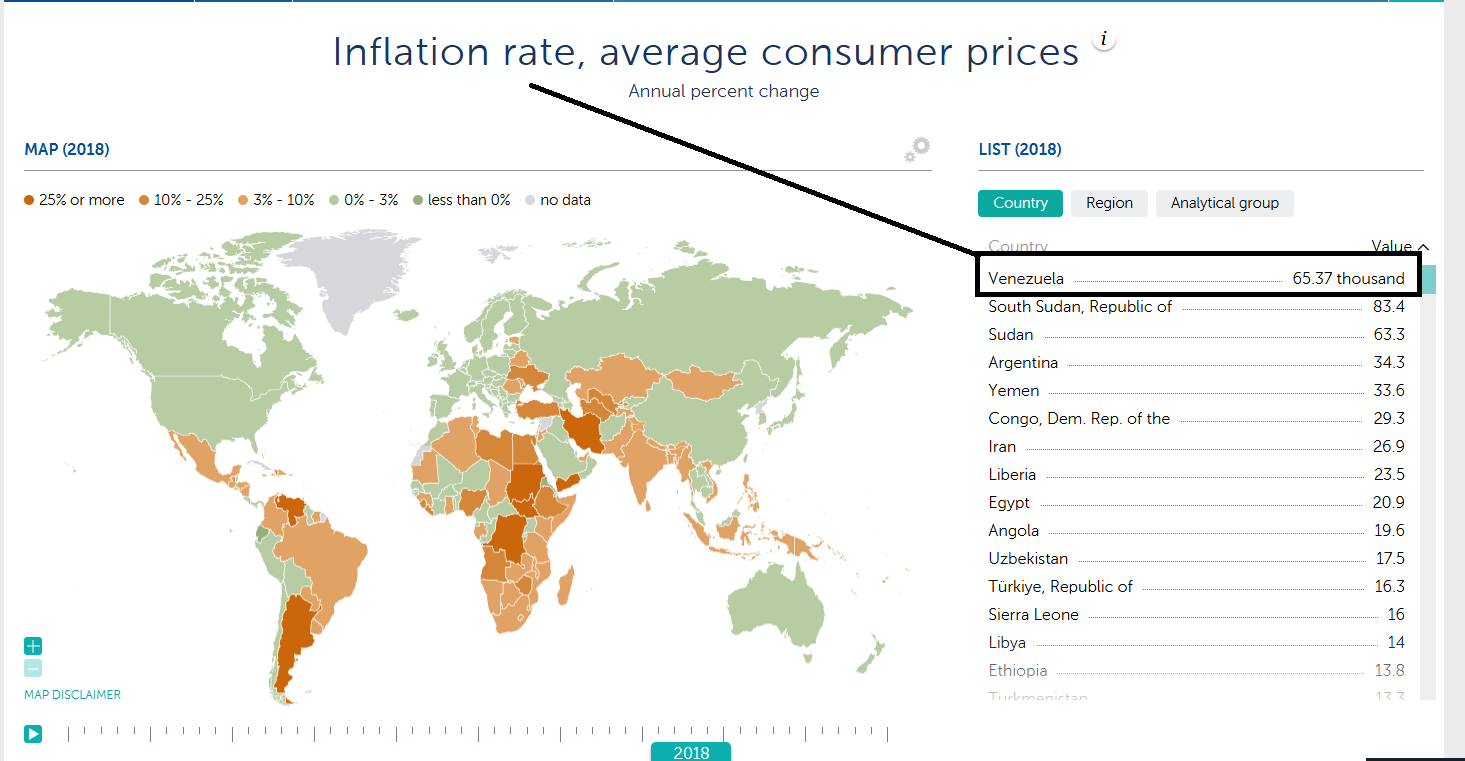
Nigeria: Stablecoins in Remittances and Trade
Nigeria, Africa’s leader in cryptocurrency adoption per Chainalysis’ Global Crypto Adoption Index, heavily utilizes stablecoins, particularly USDT, to reduce remittance costs and support trade. With traditional remittance fees reaching 8-10% (World Bank), P2P platforms like LocalBitcoins and Paxful have driven USDT adoption, enabling citizens to receive overseas funds at costs below 1%. Stablecoins also aid small businesses in international payments, mitigating risks from Naira exchange rate volatility.
Argentina: Stablecoins as a Hedging Tool
Argentina’s Peso has lost over 50% of its value annually from 2020 to 2024 (World Bank), making stablecoins like USDC and USDT popular for hedging against inflation and exchange rate fluctuations. Chainalysis ranks Argentina among the top 10 countries for stablecoin transaction volume, with platforms like Binance and Ripio reporting increased adoption by individuals and businesses for international transactions and DeFi investments.
Comparison with Asian Countries (Philippines, Vietnam)
In the Philippines, stablecoins like USDC are widely used for remittances, driven by a large overseas workforce (World Bank). In Vietnam, despite strict regulations, P2P stablecoin transactions on platforms like Binance are growing, primarily for remittances and investments. However, adoption in both countries lags behind Venezuela and Nigeria due to tighter regulatory frameworks, according to Chainalysis.
Part 7: Policy & Regulation
Perspectives of International Organizations
International organizations like the International Monetary Fund (IMF), Bank for International Settlements (BIS), and World Bank have expressed both concerns and optimism about stablecoins. The IMF warns that USD-pegged stablecoins like USDT and USDC can undermine monetary policies in emerging economies and increase financial risks due to opaque reserve backing (IMF 2023 report). The BIS emphasizes the need for a global regulatory framework to address money laundering risks and protect consumers. Conversely, the World Bank acknowledges stablecoins’ role in reducing remittance costs and promoting financial inclusion, particularly in underdeveloped regions.
Regulatory Approaches in Emerging Economies
Emerging economies adopt varied approaches to regulate stablecoins. Countries like Nigeria and the Philippines encourage their use in remittances but strengthen oversight to prevent money laundering. In contrast, nations like Vietnam and India impose strict restrictions or bans on cryptocurrency transactions, including stablecoins, to safeguard local currencies and capital controls (The Block, 2024). Argentina, grappling with high inflation, is experimenting with more flexible regulations to leverage stablecoin benefits, particularly in international trade.
Trends in Central Bank Digital Currencies (CBDCs) as Alternatives
To counter the rise of stablecoins, many emerging economies are developing central bank digital currencies (CBDCs). According to the BIS, over 20 countries, including Nigeria (eNaira) and Jamaica, have launched or piloted CBDCs by 2025. CBDCs aim to control digital money flows, reduce reliance on USD-backed stablecoins, and enhance financial autonomy. However, competition between CBDCs and stablecoins remains intense, with stablecoins holding an advantage in flexibility and global acceptance.
Part 8: Outlook & Research Implications
Future of Stablecoins in Financial Inclusion
Stablecoins are expected to continue expanding their role in promoting financial inclusion in emerging economies. By providing low-cost, accessible financial services, stablecoins like USDT and USDC can enable millions of unbanked individuals to participate in the digital financial system. Chainalysis predicts that stablecoin transaction volumes in countries like Nigeria and the Philippines could grow by over 50% annually through 2030, particularly in remittances and payments. The growth of digital wallets and DeFi platforms will further solidify stablecoins’ position.
Potential Integration with CBDCs and DeFi
Stablecoins have the potential to complement or compete with CBDCs. Some countries are exploring ways to integrate stablecoins into CBDC systems to leverage their flexibility and global blockchain networks. Meanwhile, the DeFi boom opens opportunities for stablecoins in applications like lending, staking, and liquidity provision. According to TokenTerminal, DeFi transaction volumes involving stablecoins in emerging economies are projected to double from 2025 to 2027, fostering a more robust decentralized financial ecosystem.
Implications for Policymakers and Investors
Policymakers must establish balanced regulatory frameworks that promote financial innovation while ensuring macroeconomic stability, addressing risks like money laundering and protecting local currencies. Rather than banning stablecoins, countries should consider integrating them into financial inclusion strategies. For investors, stablecoins offer opportunities in remittances, DeFi, and international trade, but caution is needed due to regulatory and market risks. Future research should focus on the long-term impact of stablecoins on economic growth and financial stability.
Part 9: Conclusion
Summary of Dual Impacts
Stablecoins offer significant benefits to emerging economies, including asset preservation against inflation, reduced remittance costs, and enhanced financial inclusion through fast, low-cost transactions. However, they also pose risks such as currency substitution, undermining national monetary policies, increasing USD dependency, and facilitating illicit activities. Case studies from Venezuela, Nigeria, and Argentina highlight stablecoins as essential tools but underscore the need for careful management.
Balancing Innovation and Macroeconomic Stability
To harness stablecoins’ potential, emerging economies must develop transparent regulatory frameworks that encourage financial innovation while safeguarding economic stability. CBDCs may serve as a complementary solution, but outright bans on stablecoins should be avoided in favor of integration into the financial system.
Directions for Future Research
Future studies should explore: (1) the long-term impact of stablecoins on economic growth and income inequality, (2) the effectiveness of CBDCs in competing with stablecoins, and (3) technological solutions to mitigate legal and financial risks.
References
CoinMarketCap: Data on market capitalization, stablecoin market share, and transaction volumes.
The Block: Information on stablecoin market capitalization ($250 billion as of June 2025) and regulatory developments.
Chainalysis: Global Crypto Adoption Index, data on P2P transactions, and stablecoin adoption in Nigeria, Venezuela, Argentina, and the Philippines.
CoinGecko: Stablecoin market capitalization ($286 billion as of August 2025) and market share.
SoSoValue: Stablecoin market capitalization growth from 2017 to 2025.
World Bank: Remittance costs (6–10%) and banking penetration in Africa (30–50%).
IMF: Inflation data (Venezuela, Argentina) and risks of currency substitution.
BIS: USD dependency, CBDC developments, and global regulatory frameworks.
TokenTerminal: DeFi transaction volumes in emerging economies.
Liberty Street Economics: Stablecoin classifications, USDT/USDC market share (86%), and currency substitution risks.
IMPACT OF STABLECOINS ON EMERGING ECONOMIES
Part 1: Introduction
Context: The Rise of Stablecoins in the Context of Financial Globalization
In the era of financial globalization, stablecoins have emerged as a prominent phenomenon in the cryptocurrency landscape. Pegged to stable assets such as the USD, gold, or managed through supply-demand algorithms, stablecoins offer price stability that traditional cryptocurrencies like Bitcoin struggle to achieve. According to data from SoSoValue, the market capitalization of stablecoins has grown exponentially, from a few billion USD in 2017 to over $200 billion in 2025, accounting for a significant share of the total cryptocurrency market. This growth not only reflects the demand for a reliable medium of exchange but also underscores the potential of stablecoins to reshape the global financial system.
Importance of Stablecoins for Emerging Economies
Emerging economies, characterized by high inflation, underdeveloped banking systems, and stringent capital controls, are witnessing a strong adoption of stablecoins. In countries like Venezuela, Nigeria, and Argentina, stablecoins such as USDT and USDC have become tools for preserving asset value, reducing remittance costs, and expanding financial access. According to Chainalysis, these countries rank among the top in the Global Crypto Adoption Index, with stablecoins dominating transaction volumes. Stablecoins serve as a bridge between traditional and decentralized finance (DeFi), offering practical solutions to economic challenges in these markets.
Research Objectives and Scope
This study aims to analyze the dual impact of stablecoins on emerging economies, including benefits such as enhanced financial inclusion and reduced cross-border transaction costs, as well as risks like threats to national monetary policies and potential illicit activities. The research focuses on emerging economies in Latin America, Africa, and select Asian countries, supported by real-world examples and data from credible sources such as CoinMarketCap, The Block, and Chainalysis. The report also examines regulatory frameworks and the development of central bank digital currencies (CBDCs) as potential alternatives.
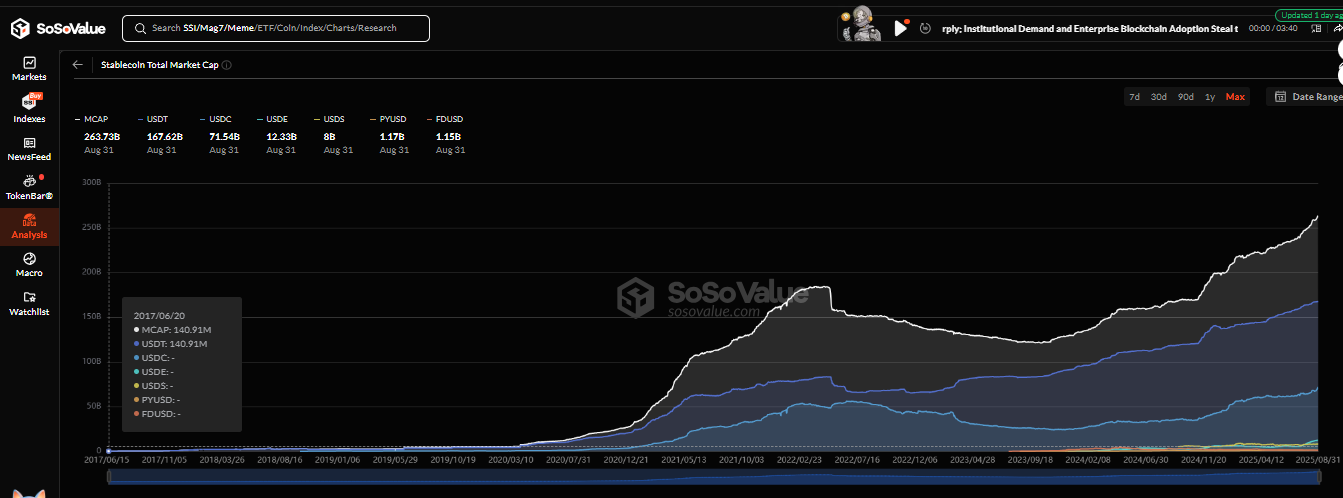
Part 2: Overview of Stablecoins
Definition and Types of Stablecoins
Stablecoins are a type of cryptocurrency designed to maintain stable value, typically pegged to assets like fiat currencies, commodities (e.g., gold, silver), or managed through algorithms. There are three main types:
Fiat-backed: Backed by fiat currencies like the USD (e.g., Tether’s USDT, Circle’s USDC), ensuring value stability through cash or equivalent reserves.
Crypto-backed: Secured by other cryptocurrencies, such as MakerDAO’s DAI, using smart contracts to maintain value.
Algorithmic: Employ algorithms to adjust supply and demand, such as FRAX, to maintain value without direct asset backing.
According to SoSoValue, USDT and USDC account for over 80% of the stablecoin market share in 2025, reflecting the dominance of fiat-backed models.
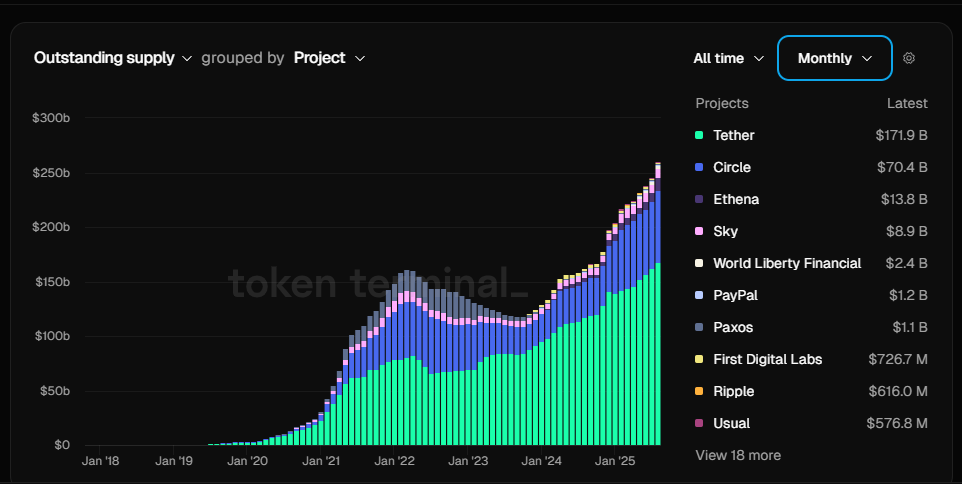
Reasons for the Strong Growth of Stablecoins
Stablecoins have thrived due to their ability to combine the stability of fiat currencies with the advantages of blockchain technology: fast transactions, low costs, and borderless accessibility. The rise of decentralized finance (DeFi) and the demand for cross-border payments have fueled this growth. Per SoSoValue, stablecoin market capitalization grew from $5.9 billion in 2017 to over $200 billion in 2025, with a compound annual growth rate (CAGR) exceeding 50%. Factors such as global inflation, instability of local currencies, and the need for financial inclusion in emerging economies further reinforce the role of stablecoins.
Role as a Bridge Between Crypto and Traditional Finance
Stablecoins act as intermediaries, enabling users to participate in cryptocurrency markets without exposure to price volatility. They are widely used in DeFi (lending, staking), international payments, and remittances. For example, platforms like Stellar and Ripple leverage stablecoins to reduce transaction costs compared to SWIFT. Stablecoins also enable businesses to integrate blockchain into commercial operations, serving as a bridge between traditional and decentralized finance.
Part 3: Economic Characteristics of Emerging Economies
Economic Characteristics
Emerging economies, such as those in Latin America, Africa, and parts of Asia, exhibit distinct economic features:
High Inflation: According to IMF data, countries like Venezuela (with inflation exceeding 1,000% in 2023), Argentina, and Zimbabwe frequently face hyperinflation, eroding the value of local currencies.
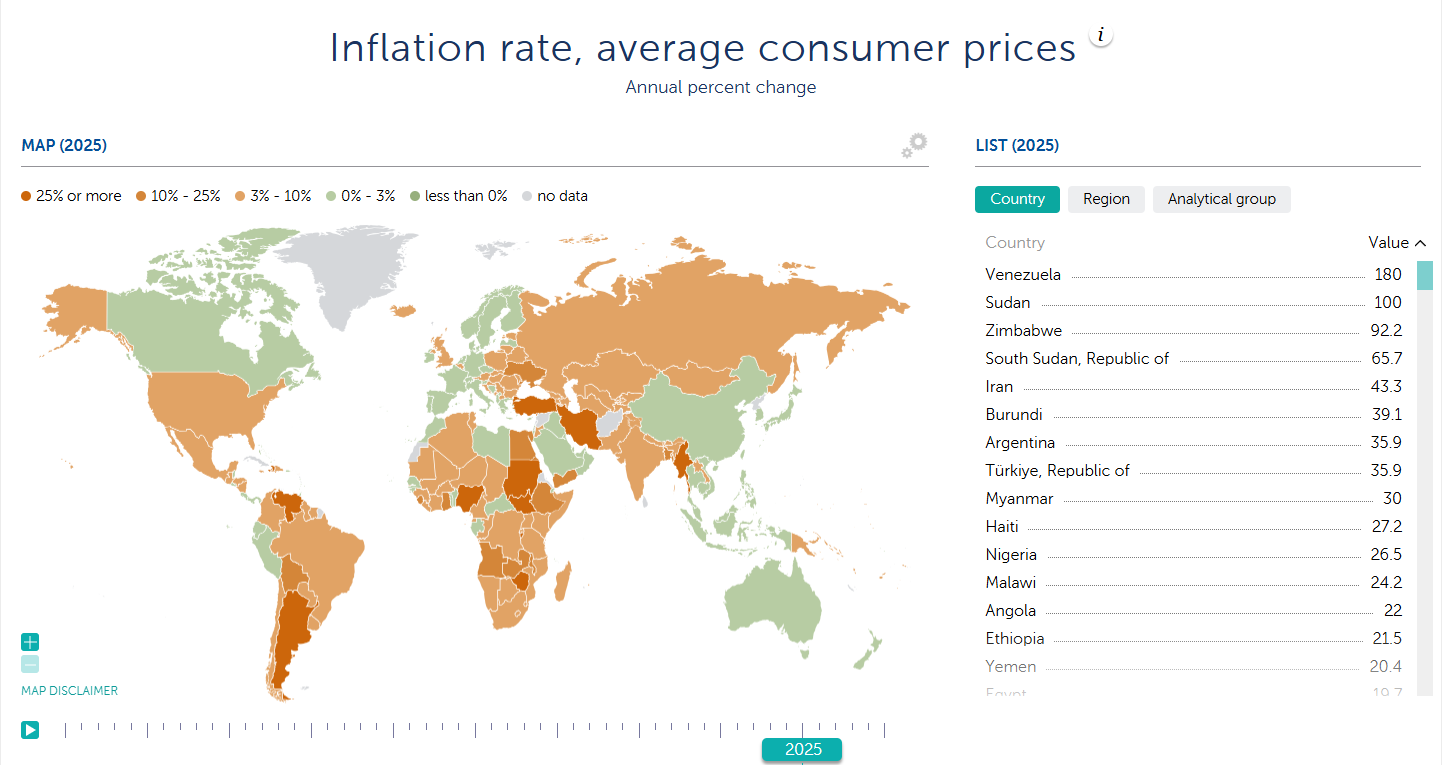
Weak Banking Systems: Financial systems in these countries are often inefficient, with low banking penetration (only 30-50% of the population in Africa has bank accounts, per World Bank data).
Strict Capital Controls: Nations like Nigeria and Vietnam impose restrictions on capital flows to protect exchange rates, complicating international transactions.
Common Challenges
Emerging economies face several challenges:
Lack of Confidence in Local Currencies: Continuous currency devaluation drives citizens to seek alternative assets like USD or gold to preserve value.
High Remittance Costs: According to the World Bank, remittance fees in these economies range from 6-10%, significantly higher than the global average.
Exchange Rate Risks: Strong currency fluctuations increase risks for international trade and investment, particularly in import-dependent countries.
Why Stablecoins Are Attractive
Stablecoins offer compelling solutions due to their characteristics:
Value Stability: Pegged to stable assets like the USD, stablecoins protect against inflation and exchange rate volatility.
Fast, Low-Cost Transactions: Blockchain platforms like Stellar or Ethereum enable cross-border transfers with fees below 1%, compared to traditional services like Western Union.
Financial Inclusion: Stablecoins allow unbanked individuals to access digital financial systems via mobile wallets. According to Chainalysis’ Global Crypto Adoption Index, countries like Nigeria and the Philippines lead in stablecoin adoption, particularly for payments and remittances.
Part 4: Positive Impacts of Stablecoins
1. Value Stability and Asset Preservation
Stablecoins, pegged to stable assets like the USD (e.g., USDT, USDC) or managed by algorithms (e.g., FRAX), are effective tools for protecting against inflation in emerging economies. In countries like Venezuela and Argentina, where annual inflation often exceeds 50% (IMF), stablecoins help citizens preserve asset value as local currencies like the Bolivar or Peso rapidly depreciate. For instance, USDT is widely used as an alternative store of value in Venezuela and Argentina, offering stability that local fiat currencies cannot provide.
2. Cross-Border Payments
Stablecoins significantly reduce the cost and time of remittance transactions compared to traditional methods like Western Union or SWIFT. The World Bank reports average remittance fees in emerging economies at 6-10%, while stablecoin transactions on platforms like Stellar or Ethereum cost less than 1%. In Nigeria, USDT is popular on P2P platforms like Paxful, enabling fast, low-cost remittances and boosting foreign capital inflows.
3. Enhancing Financial Inclusion
Stablecoins expand access to financial services for the unbanked, particularly in Africa and Latin America, where over 50% of the population lacks banking access (World Bank). With just a smartphone and digital wallet, users can store, transfer, and use stablecoins for payments or DeFi participation. Chainalysis reports a 120% growth in stablecoin wallet usage in Africa from 2020 to 2024, driving financial inclusion in rural areas.
4. Bridge to DeFi and International Trade
Stablecoins serve as a key intermediary in DeFi transactions, such as lending, staking, or providing liquidity on platforms like Aave and Uniswap. They also facilitate international trade by reducing exchange rate risks and transaction costs. For example, small businesses in the Philippines use USDC to pay international suppliers, leveraging blockchain’s speed and transparency. According to TokenTerminal, stablecoin transaction volume in DeFi within emerging economies tripled from 2021 to 2025.
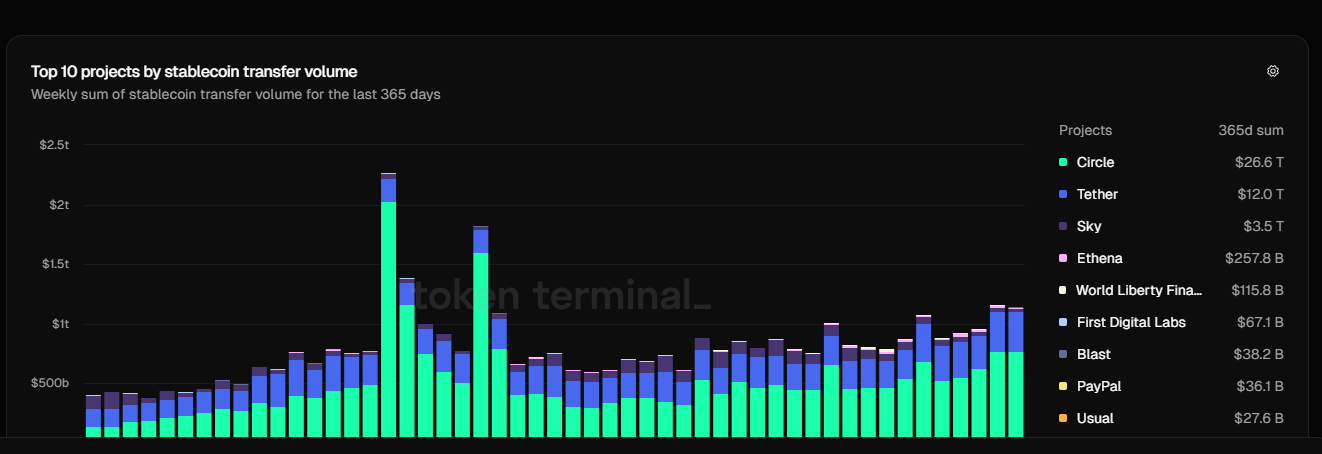
Part 5: Negative Impacts & Risks of Stablecoins
1. Currency Substitution Risk
Stablecoins, particularly those pegged to the USD like USDT and USDC, pose a threat to national monetary policies in emerging economies. When citizens lose confidence in local currencies and adopt stablecoins for transactions or value storage, central banks lose control over money supply and interest rate policies. According to the IMF, widespread USDT use in Venezuela has weakened the Bolivar, complicating macroeconomic policies. This phenomenon, known as “currency substitution,” undermines a country’s financial autonomy.
2. Risk of Money Laundering and Terrorist Financing
The anonymity and cross-border nature of stablecoins facilitate illicit activities such as money laundering or terrorist financing. Chainalysis reports that while less than 1% of stablecoin transactions are linked to illegal activities, this still represents a significant volume in regions with weak regulatory oversight, such as Nigeria or Zimbabwe. Emerging economies with limited financial monitoring systems are particularly vulnerable to exploitation by criminal organizations using stablecoins for cross-border transfers.
3. Dependency on the USD
Most popular stablecoins are pegged to the USD, creating economic dependency on the United States in emerging markets. Changes in U.S. monetary policy, such as interest rate hikes, can impact global capital flows and exacerbate economic imbalances in import-dependent countries. According to the BIS, the dominance of USD-backed stablecoins may reduce the effectiveness of local exchange rate policies and intensify economic vulnerabilities.
4. Legal and Capital Control Volatility
The lack of clear regulatory frameworks for stablecoins creates significant risks. Many emerging economies, such as Vietnam and India, impose restrictions or outright bans on cryptocurrencies, including stablecoins, to protect traditional financial systems. According to The Block, over 20 countries introduced stablecoin restrictions between 2020 and 2025, leading to risks of asset seizure or frozen digital wallets. This creates uncertainty for users and businesses relying on stablecoins.
Part 6: Case Studies
Venezuela: Hyperinflation and the Role of USDT
Venezuela exemplifies the use of stablecoins to combat hyperinflation. According to the IMF, inflation in Venezuela peaked at over 65,000,000% in 2018 and has remained in triple digits in recent years. The Bolivar’s severe devaluation has driven citizens to adopt USDT to preserve assets and conduct daily transactions. Data from Paxful and Chainalysis shows a 200% increase in USDT P2P transaction volume in Venezuela from 2020 to 2024, with many using stablecoins to purchase imported goods or transfer funds abroad, bypassing capital controls
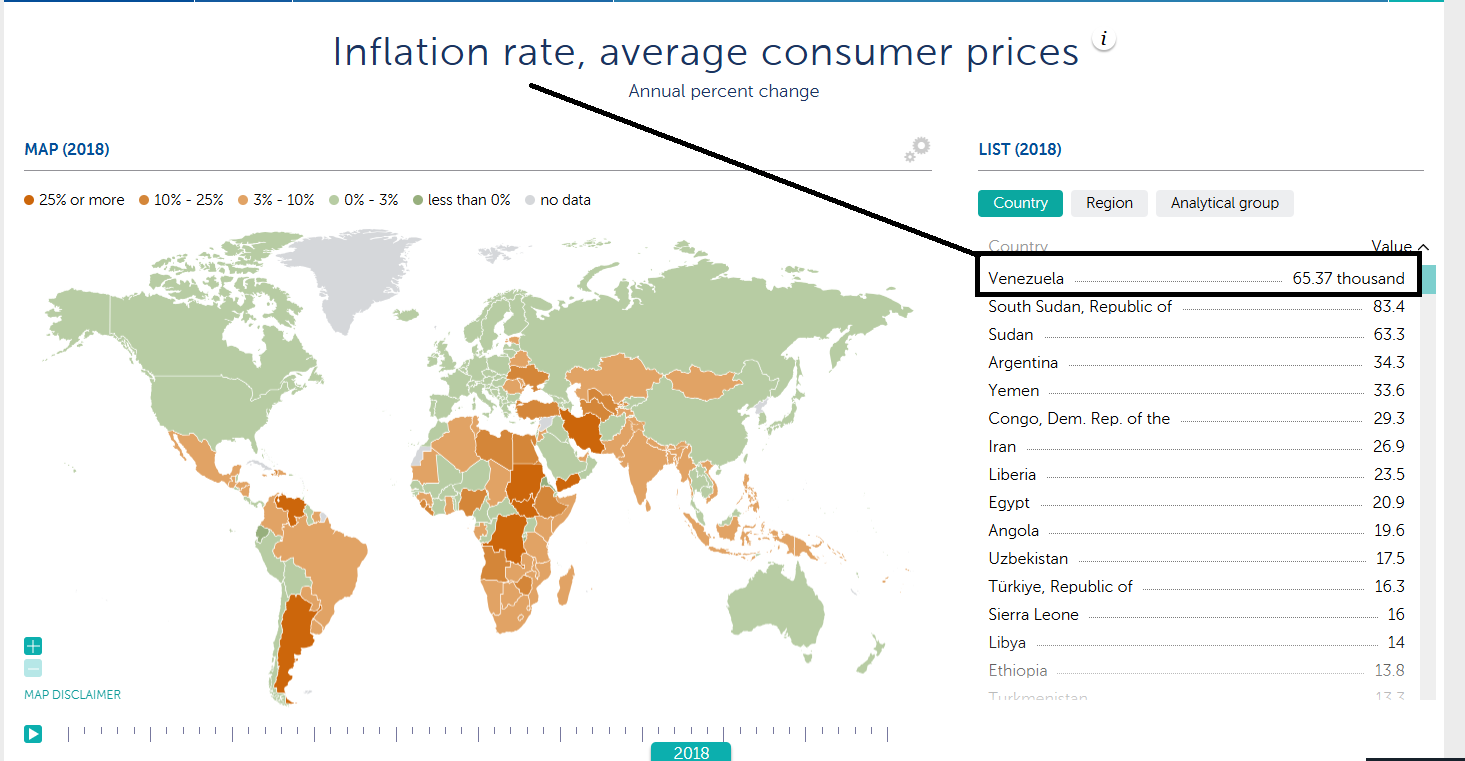
Nigeria: Stablecoins in Remittances and Trade
Nigeria, Africa’s leader in cryptocurrency adoption per Chainalysis’ Global Crypto Adoption Index, heavily utilizes stablecoins, particularly USDT, to reduce remittance costs and support trade. With traditional remittance fees reaching 8-10% (World Bank), P2P platforms like LocalBitcoins and Paxful have driven USDT adoption, enabling citizens to receive overseas funds at costs below 1%. Stablecoins also aid small businesses in international payments, mitigating risks from Naira exchange rate volatility.
Argentina: Stablecoins as a Hedging Tool
Argentina’s Peso has lost over 50% of its value annually from 2020 to 2024 (World Bank), making stablecoins like USDC and USDT popular for hedging against inflation and exchange rate fluctuations. Chainalysis ranks Argentina among the top 10 countries for stablecoin transaction volume, with platforms like Binance and Ripio reporting increased adoption by individuals and businesses for international transactions and DeFi investments.
Comparison with Asian Countries (Philippines, Vietnam)
In the Philippines, stablecoins like USDC are widely used for remittances, driven by a large overseas workforce (World Bank). In Vietnam, despite strict regulations, P2P stablecoin transactions on platforms like Binance are growing, primarily for remittances and investments. However, adoption in both countries lags behind Venezuela and Nigeria due to tighter regulatory frameworks, according to Chainalysis.
Part 7: Policy & Regulation
Perspectives of International Organizations
International organizations like the International Monetary Fund (IMF), Bank for International Settlements (BIS), and World Bank have expressed both concerns and optimism about stablecoins. The IMF warns that USD-pegged stablecoins like USDT and USDC can undermine monetary policies in emerging economies and increase financial risks due to opaque reserve backing (IMF 2023 report). The BIS emphasizes the need for a global regulatory framework to address money laundering risks and protect consumers. Conversely, the World Bank acknowledges stablecoins’ role in reducing remittance costs and promoting financial inclusion, particularly in underdeveloped regions.
Regulatory Approaches in Emerging Economies
Emerging economies adopt varied approaches to regulate stablecoins. Countries like Nigeria and the Philippines encourage their use in remittances but strengthen oversight to prevent money laundering. In contrast, nations like Vietnam and India impose strict restrictions or bans on cryptocurrency transactions, including stablecoins, to safeguard local currencies and capital controls (The Block, 2024). Argentina, grappling with high inflation, is experimenting with more flexible regulations to leverage stablecoin benefits, particularly in international trade.
Trends in Central Bank Digital Currencies (CBDCs) as Alternatives
To counter the rise of stablecoins, many emerging economies are developing central bank digital currencies (CBDCs). According to the BIS, over 20 countries, including Nigeria (eNaira) and Jamaica, have launched or piloted CBDCs by 2025. CBDCs aim to control digital money flows, reduce reliance on USD-backed stablecoins, and enhance financial autonomy. However, competition between CBDCs and stablecoins remains intense, with stablecoins holding an advantage in flexibility and global acceptance.
Part 8: Outlook & Research Implications
Future of Stablecoins in Financial Inclusion
Stablecoins are expected to continue expanding their role in promoting financial inclusion in emerging economies. By providing low-cost, accessible financial services, stablecoins like USDT and USDC can enable millions of unbanked individuals to participate in the digital financial system. Chainalysis predicts that stablecoin transaction volumes in countries like Nigeria and the Philippines could grow by over 50% annually through 2030, particularly in remittances and payments. The growth of digital wallets and DeFi platforms will further solidify stablecoins’ position.
Potential Integration with CBDCs and DeFi
Stablecoins have the potential to complement or compete with CBDCs. Some countries are exploring ways to integrate stablecoins into CBDC systems to leverage their flexibility and global blockchain networks. Meanwhile, the DeFi boom opens opportunities for stablecoins in applications like lending, staking, and liquidity provision. According to TokenTerminal, DeFi transaction volumes involving stablecoins in emerging economies are projected to double from 2025 to 2027, fostering a more robust decentralized financial ecosystem.
Implications for Policymakers and Investors
Policymakers must establish balanced regulatory frameworks that promote financial innovation while ensuring macroeconomic stability, addressing risks like money laundering and protecting local currencies. Rather than banning stablecoins, countries should consider integrating them into financial inclusion strategies. For investors, stablecoins offer opportunities in remittances, DeFi, and international trade, but caution is needed due to regulatory and market risks. Future research should focus on the long-term impact of stablecoins on economic growth and financial stability.
Part 9: Conclusion
Summary of Dual Impacts
Stablecoins offer significant benefits to emerging economies, including asset preservation against inflation, reduced remittance costs, and enhanced financial inclusion through fast, low-cost transactions. However, they also pose risks such as currency substitution, undermining national monetary policies, increasing USD dependency, and facilitating illicit activities. Case studies from Venezuela, Nigeria, and Argentina highlight stablecoins as essential tools but underscore the need for careful management.
Balancing Innovation and Macroeconomic Stability
To harness stablecoins’ potential, emerging economies must develop transparent regulatory frameworks that encourage financial innovation while safeguarding economic stability. CBDCs may serve as a complementary solution, but outright bans on stablecoins should be avoided in favor of integration into the financial system.
Directions for Future Research
Future studies should explore: (1) the long-term impact of stablecoins on economic growth and income inequality, (2) the effectiveness of CBDCs in competing with stablecoins, and (3) technological solutions to mitigate legal and financial risks.
References
CoinMarketCap: Data on market capitalization, stablecoin market share, and transaction volumes.
The Block: Information on stablecoin market capitalization ($250 billion as of June 2025) and regulatory developments.
Chainalysis: Global Crypto Adoption Index, data on P2P transactions, and stablecoin adoption in Nigeria, Venezuela, Argentina, and the Philippines.
CoinGecko: Stablecoin market capitalization ($286 billion as of August 2025) and market share.
SoSoValue: Stablecoin market capitalization growth from 2017 to 2025.
World Bank: Remittance costs (6–10%) and banking penetration in Africa (30–50%).
IMF: Inflation data (Venezuela, Argentina) and risks of currency substitution.
BIS: USD dependency, CBDC developments, and global regulatory frameworks.
TokenTerminal: DeFi transaction volumes in emerging economies.
Liberty Street Economics: Stablecoin classifications, USDT/USDC market share (86%), and currency substitution risks.
 00:00
00:00